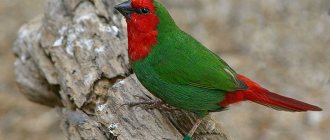- Wild animals
- >>
- Arachnids
The tarantula spider , or tarantula, has a rather memorable and very colorful appearance.
This insect is quite large in size, has long, hairy limbs and a bright color, which becomes even brighter with each subsequent molt. This type of spider is divided into many subspecies. However, they are all considered poisonous to one degree or another. For an adult, healthy person, their bite is unlikely to be fatal, but can provoke chills, nausea, vomiting, convulsions, high fever, a severe allergic reaction, and burns. For an elderly, weakened person, or a child, or a small animal, a bite from this insect can be fatal.
Origin of the species and description
Photo: Tarantula spider
This spider belongs to arthropod insects, is a representative of the class of arachnids, the order of spiders, the family of tarantula spiders. The name of this poisonous spider comes from a painting by the German artist Maria Sibylla Merian, who depicted a spider attacking a hummingbird. She herself witnessed this episode, which she was able to observe during her stay in Suriname.
These spiders belong to the suborder of primitive arachnids. In various sources they are often classified as tarantulas. However, this is due to an incorrect, not entirely correct translation of their name. Many scientists and researchers consider it advisable to classify tarantulas into a separate class of insects, such as scorpions.
Video: Tarantula Spider
The first description of this type of arthropod appeared in the 18th century after a German artist returned from a long trip along the coast of South America, where few people had been in those days. After she witnessed an unusual scene of a spider attacking a small bird, she transferred it to her canvas. Upon arrival home, the picture was presented to society. However, this episode was severely criticized by the public, since no one could believe that an insect could feed on small invertebrate animals or birds.
However, after just a century and a half, sufficient evidence was obtained for this phenomenon and the name tarantula spider was very firmly attached to the arthropod. Today, spiders are quite common on different continents. They are divided into many subspecies, of which researchers number about a thousand.
How to avoid being bitten?
To avoid being bitten by such a spider, you should carefully monitor its behavior. The spiders themselves are quite peaceful and never attack first. Before biting, they hiss demonstratively and raise their front or hind legs. Often the attack occurs due to the carelessness of the owners themselves. Here are some tips to help avoid such cases:
- You should not act with an animal if they behave aggressively: they hiss and raise their front paws.
- You should not touch the female while the kokan is forming. In general, females are believed to be more aggressive than males. Spiders can behave aggressively during the period before and after mating.
- You should not touch the spider during molting, as the animal is most aggressive during this period.
- To make your pet more friendly, you should follow a special diet. Although spiders are fairly unpretentious eaters, their diet should be controlled not only to maintain their health, but also to increase their lifespan.
- It should be remembered that the tarantula is a dangerous and predatory creature, and you should not take it as a pet if you are unsure of its abilities. You should not get such a pet if you feel fear or disgust towards the animal.
Important! After any contact with an arachnid, you should wash your hands thoroughly. You should not come into contact with the spider while eating or cooking.
Spiders are not insects, although many people call them that. They differ from this species in characteristic features and belong to the class of arachnids and the phylum of arthropods. Not all spiders in Russia are dangerous to human life, but they all emit toxic substances. More than 40 species of arachnids, which belong to 32 families, live on the territory of the Russian Federation.
The species lives in tree crowns, nets are placed between the branches, and the leaves are used to make shelters. Wheel-shaped traps immediately attract attention in a forest or garden. Sometimes round nets are placed under the eaves, in the window frames of abandoned houses.
The poison is toxic to invertebrates and small vertebrates; it affects rats, rabbits, mice, but horses, dogs, guinea pigs and sheep do not react to the bite. The locust's muscles lock up after 35 minutes, and the frog stops moving within 15 minutes. When bitten, a person experiences mild pain, but the volume of injected poison remains safe.
Orb weavers have an increased appetite and eat up to 8 insects at one time. If there is prey that is unacceptable to it in the trap, then the owner breaks off the web around it and the insect falls. It does network cleaning in the same way.
Argiope arthropods
Arachnids of this species are not dangerous to large mammals and humans. Males are modest in size and rarely exceed 0.5 cm, while females grow up to 2.5−3 cm. The color of the back resembles a wasp due to its bright black and yellow stripes. Short hair grows on the chest and partly on the head. The long legs consist of several jointed sections and are black with pale yellow spots.
Argiopes are spiders of central Russia, because they prefer areas with a temperate climate. They are also found in the southern part of the Stavropol Territory. The bite of an arthropod is compared to that of a bee; spiders do not attack first and do not show aggression. A slight pain is felt at the site of the lesion, swelling appears, but everything returns to normal after 2-3 days.
Trudoviks knitters
The species is distributed throughout the Russian territory and is found more often than in other countries. They almost always prefer nature and do not live in buildings. For hunting, round nets with large rectangular cells are made. The observer sees that such a product is not suitable for fishing due to the rare threads, but it’s all about the specific victim that must fall into the net. Knitters hunt for long-legged mosquitoes, which are a favorite delicacy.
Knitter Description:
- the body has an oblong shape;
- long legs consist of segmented segments;
- many outgrowths are observed on the chelicerae;
- females are large, reaching 3 cm, but males are inferior in height.
The long body saves the knitter in case of danger. At a moment of anxiety, he stretches his legs along his body and in this position resembles a dry twig. If it is disturbed in this state, the spider quickly falls and quickly runs away.
Appearance and features
Photo: Goliath tarantula spider
The tarantula spider has a rather memorable, bright appearance. It has long limbs covered with hard, thick hairs. They perform the function of the organs of touch and smell.
Visually, it seems that arthropods have six pairs of limbs, but if you look closely, it becomes clear that the spider has only four pairs of limbs. These are paws, one pair of which is chelicerae, which are used for digging holes, protection, hunting and moving caught prey, as well as pedipalps, which serve as organs of touch. The chelicerae, which contain ducts of the poisonous glands, are directed forward.
Some subspecies are quite large in size, reaching 27-30 centimeters. On average, the body length of one adult individual ranges from 4 to 10-11 centimeters, excluding the length of the limbs. The average body weight is 60-90 grams. However, there are individuals whose weight reaches about 130-150 grams.
Each of the subspecies of this species has a bright and very specific color. With each subsequent molt, the color becomes brighter and more saturated.
Interesting fact: During the molting period, not only the color becomes brighter and more saturated, but also the body size increases. Some individuals can increase their size three to four times at the moment of molting!
Sometimes during the molting process the spider is unable to free its limbs. By nature they are endowed with the ability to reject them. However, after three or four moults they are restored again.
The body of the arthropod consists of two segments: the cephalothorax and abdomen, which are connected to each other by a dense isthmus. The body segments are covered with a dense exoskeleton - chitin. This protective layer protects arthropods from mechanical damage and helps prevent excessive moisture loss. This is especially important for those insects that live in regions with hot, dry climates.
The cephalothorax is protected by a solid shield called a carapace. On its front surface there are four pairs of eyes. The organs of the digestive tract and reproductive system are located in the abdomen. At the end of the abdomen there are appendages that allow us to weave spider threads.
Nutrition
The Goliath tarantula spider owes its name to the German entomologist Maria Merian. While traveling through the countries of South America, she saw a picture of a huge spider eating a hummingbird. The information immediately hit the press, and that’s how the name was attached.
The main diet of the Goliath spider:
- insects;
- snakes;
- snakes;
- beetles;
- small birds, chicks;
- snakes;
- frogs;
- toads;
- rodents;
- small arachnids.
The predator does not build trapping nets, does not weave webs, and prefers active hunting. Moves around the area, stalks prey. At the right moment, it instantly attacks, bites with long fangs, injects poison and its own saliva. The first substance paralyzes the victim, the second liquefies the insides. The Goliath spider waits on the sidelines for some time; when the victim’s convulsions stop, he begins to eat.
Goliath spider feeding
Hunts in the dark, sits in a secluded place during the day. This behavior is associated with the presence of a large number of natural enemies - the cat and dog family. Defending itself from an attacker, the goliath tarantula turns its back to him and quickly sheds thin, spiky hairs containing poison. While the predator comes to its senses, the spider crawls away.
Interesting!
The arthropod is capable of regenerating a damaged limb. Initially, it discharges the residues, then directs liquid there, which over time turns into a solid formation. The process is long, but eventually a new leg is formed. Throughout her life, the female molts 5-7 times. In this way, she sheds parasites, increases in size, and renews her poisonous coat.
Where does the tarantula spider live?
Photo: Dangerous tarantula spider
Tarantula spiders are quite common in nature and live almost throughout the entire globe. The only exception is the territory of Antarctica. Spiders are found somewhat less frequently in Europe than in other regions.
Geographical regions of distribution of arthropods:
- South America;
- North America;
- Australia;
- New Zealand;
- Oceania;
- Italy;
- Portugal;
- Spain.
The habitat region is largely determined by the species. Some species are drought-resistant and live in deserts with a hot, sultry climate. Others prefer tropical or equatorial forest areas. Depending on the environment and type of habitat, spiders are divided into several categories: burrowing, arboreal and earthen. Accordingly, they live in burrows, in trees or bushes, or on the surface of the ground.
It is characteristic that at various stages of their development spiders can change their appearance and place of residence. The larvae, which at this stage live in burrows, emerge from the burrows upon reaching puberty and spend most of their time on the surface of the earth. Many tarantulas that prefer to live in burrows dig them themselves and strengthen them by entwining them with cobwebs. In some cases, burrows may be occupied by small rodents that have been eaten by a spider. Spiders that live on trees or shrubs can construct special tubes from their webs.
Due to the fact that spiders are considered sedentary arthropods, they spend most of their time in selected or made shelters. Female individuals who have eaten tightly and thoroughly may not leave their shelters for several months.
Now you know where the tarantula spider lives, let's now see what you can feed the tarantula.
Danger to humans
Tarantulas do not threaten the health and life of their owner. But when carrying out any activities to care for your pet, you must adhere to precautions. All species of spiders are poisonous to one degree or another. If we talk about non-poisonous species, then we mean a low degree of toxicity of the poison.
An animal bite leads to the death of small rodents. There have been recorded cases of domestic cats dying due to spiders. The bite is likely to be dangerous to the health of young children.
Females in the active stage of motherhood show increased aggression. But in other cases it is impossible to predict the reaction of an arthropod to any, even the most harmless, actions. That is why it is not recommended to touch them with your hands. Before purchasing a tarantula, you need to acquire a special terrarium, as well as long tweezers for carrying out all kinds of manipulations.
Whether the venom is toxic or not depends on the type of spider. For an adult, the danger of a tarantula bite will be equal to a wasp sting: a burning pain is felt and swelling appears. With increased sensitivity of the body to toxins, an increase in body temperature, fainting, muscle cramps, vomiting and even mental disorders are observed. When a tarantula bites through the skin, venom is not always injected; most often, so-called “dry” bites occur.
The danger comes from the hairs covering the legs and body of the arthropod. When under stress, the spider is able to quickly pull out fibers with its paws, trying to throw them to the enemy.
When hairs come into contact with human skin, they cause burns and allergic reactions. Contact with the mucous membrane of the eyes causes severe burning and itching that does not go away for several hours, and in some cases, days. Sometimes toxins lead to deterioration in the quality of vision for the rest of your life.
The tarantula spider really poses a danger to humans. If the potential owner of such a “pet” animal is not afraid of a health threat, the exotic appearance of the arthropod is not repulsive, but attracts, you can safely keep it at home. But at the same time, we must not forget about the rules of keeping a pet and safety precautions.
What does a tarantula spider eat?
Photo: Poisonous tarantula spider
Insects rarely eat meat, but they are considered predators and eat exclusively animal food. The structural features of the digestive tract require easily digestible, delicate food.
What serves as a food source for tarantula spiders:
- birds;
- small rodents and invertebrates;
- insects;
- smaller arthropods, including spiders;
- fish;
- amphibians.
The digestive organs are designed in such a way that they cannot cope with poultry meat. However, in nature there are indeed cases of spider attacks on small birds. The main part of the diet of tarantulas is small insects - cockroaches, bloodworms, flies, arthropods. Relatives of arachnids can also become prey.
Tarantula spiders cannot be called active insects, therefore, in order to catch their prey, they most often wait for their prey in ambush. Thanks to their hypersensitive hairs, they sense every movement of potential prey. They are also able to determine the size and type of prey. When she gets as close as possible, the spider attacks with lightning speed, injecting poison into her.
During the period when spiders are too hungry, they can chase the victim, or carefully sneak up on it until they get as close as possible. Spiders that have just emerged from eggs do not experience hunger or need for food.
Conditions of detention
This breed is not suitable for novice breeders. Before purchasing a pet, you need to familiarize yourself with its features, advantages and disadvantages of keeping it. On the Internet you can very easily find a description of the insect breed you are interested in.
Goliaths are considered aggressive from birth. That is why a beginner should not take risks. Experienced collectors will not mind adding an interesting specimen to their collection. For a comfortable stay at home, the tarantula will need:
- spacious terrarium. Each enclosure contains only one individual;
- litter up to 10 cm high. The soil can be a mixture of sand and soil or coconut shavings;
- fresh water must be constantly available to the insect;
- lighting can be provided by moonlight lamps;
- Daytime temperatures vary from 24 to 28 degrees. At night - up to 22. At the same time, air humidity is 90 percent;
- Every day the soil is sprayed with warm water. It is very important to prevent overwatering;
- young individuals feed two to three times a week, while adults only need one.
The lifespan of the Goliath tarantula spider depends on gender. Females live a long, happy life - 20 years, males - 4 years.
Overall, the goliath is an unusual exotic insect. To most people, tarantulas seem like scary creatures. However, there are also those who are delighted with arthropods and have their own collections at home.
Many people are interested in how much a spider costs and where in Moscow they can buy it? Experts recommend purchasing insects from professional breeders. The price depends on the size and age of the individual.
Features of character and lifestyle
Photo: Tarantula spider
The tarantula spider leads a solitary lifestyle. They tend to spend most of their time in their chosen shelters. If spiders are full, they may not leave their shelter for several months. These types of spiders typically lead a solitary, sedentary lifestyle. If necessary, spiders leave their shelter mainly at night.
This type of arthropod is characterized by unpredictable behavior, as well as changing habits throughout different life cycles. When choosing shelter, spiders prefer to locate themselves close to vegetation to increase their chances of finding a food source. Adult spiders that live in the crowns of trees have a better ability to weave webs.
One of the most important processes in the life of every arthropod is molting. Young individuals molt almost every month. The older the spider gets, the less often it molts. During molting, the pack grows and improves its color. Before molting, spiders stop feeding to make it easier to free themselves from the tight chitinous cover. Most often, arthropods turn over on their backs in order to free themselves from the shell more easily and quickly.
Tarantula spiders are deservedly considered record holders for life expectancy. Some individuals live up to 30 years. Average life expectancy is 20-22 years. Despite their impressive size, tarantulas have many enemies when living in natural conditions.
For self-defense, arthropods have means of defense:
- excrement attack;
- bites with injection of poison;
- burning villi in the abdominal area.
With the help of hairs, females protect their future offspring. They weave them into a web that entangles the cocoon. An effective weapon that scares away enemies is considered to be a stream of excrement that spiders direct into the enemy's eye.
Did you know?
- Tarantula spiders are often brown in color, which may have lighter or darker shades. It all depends on where they live.
- Some species blind predators with a stream of excrement thrown in their direction.
- Tarantulas have four pairs of legs, with distinct spines on the third and fourth pair of legs.
- Tarantulas can go without food for up to 2 years!
- Tarantula spiders are used to treat fear of arachnids.
- These are some of the most popular exotic animals, especially on the black market.
Social structure and reproduction
Photo: Large tarantula spider
Males mature much faster than females, but their life expectancy is much lower than that of females. A male individual lives no more than a year, and if he manages to mate with a female, he lives even less.
Males have special hooks, which are usually called tibal hooks. With their help, males hold females and at the same time protect themselves from them, since during the mating process females can be unpredictable and quite aggressive. Before starting to search for a suitable companion, males weave a special web, onto which they secrete a small amount of seminal fluid. Then they grab the edge of the web with their limbs and pull it along with them.
Even if the female is attracted to a potential partner, mating does not occur without performing special rituals. With their help, arthropods find out whether they belong to the same species or not. Each species is characterized by special rituals for recognizing relatives: swaying the body, tapping the limbs, etc.
The mating process can be instantaneous, or it can last several hours. It involves the males using their pedipalps to transfer seminal fluid into the female’s body. After the end of mating, the males immediately try to move away. Otherwise, the female eats the male.
Subsequently, eggs are formed in the female’s body. When the time comes, the female lays eggs. The number of eggs depends on the subspecies. The female can lay from several dozen to thousands of eggs. Then the female makes a kind of cocoon in which she lays her eggs and incubates them. This process lasts from 20 to one hundred days.
During this period, females are especially aggressive and unpredictable. They can desperately and fearlessly protect their future offspring, or they can eat everything without hesitation if they feel a strong feeling of hunger. Nymphs emerge from the cocoon, which during the molting process grow and turn into larvae, and then into adults.
FAQ
Below are answers to the most frequently asked questions regarding the biology, physiology, keeping of tarantulas in captivity, etc.
- Is it worth keeping a tarantula spider at home?
- How long do tarantulas live?
- Which tarantula is the largest and which is the smallest?
- Are tarantula spiders poisonous and how poisonous are they?
- What species of tarantulas are most dangerous to keep in captivity?
- What tarantulas can be recommended for beginners?
- What necessary conditions must be created for tarantulas for their successful maintenance and breeding in captivity?
- How to distinguish a tarantula from another spider?
- What does it mean when a spider refuses food for a long time?
- How can you tell if a spider is about to molt?
- How to distinguish a male tarantula from a female?
- My adult spider moulted, and something was wrong with it - it changed color (body proportions, it had strange growths on its legs, etc.), in general, became “completely different”?
- How to determine the onset of sexual maturity of a female tarantula?
- Is it possible to pick up (transplant/carry) a tarantula with your hands?
- Here I have such a tarantula (photo attached). What kind is this?
- Is it necessary to heat a tarantula?
- How to heat terrariums with tarantulas?
- How often should you feed a tarantula?
- What size should the food object be?
- How should I feed my tarantula?
- My spider lost/injured its leg - will it die?
- Why does my tarantula have a bare patch of “skin” on its abdomen?
- The bare area on my spider's abdomen has turned dark, what is it?
- I found my spider lying on its back, did it die?
- I often observe that my spider climbs and sits on the walls of the terrarium. Why?
- My tarantula has barely moved/come out of its hole for the past few days/weeks. Is he okay?
- Some flies have appeared and are flying around in the terrarium with the tarantula. What to do - will they harm the tarantula?
- My spider sits with its legs tucked under itself and doesn’t move, what’s wrong with it?
- Bought a very small tarantula, when will it grow up?
- How to choose the right terrarium (type, size) and place it in the apartment?
- I want to equip my terrarium with live plants. What plants to use and is it necessary at all?
- How to set up a terrarium for my tarantula?
- Is it possible to keep tarantulas together?
- Is it possible to keep tarantulas of different species together?
- What substrate should I use to keep a tarantula?
- Is it worth getting a tarantula spider?
Probably, if you ask yourself this question and hesitate, then it’s better not to. Firstly, this is a very unconventional “pet”, the content of which is associated with a number of problems, which this site is particularly devoted to. Secondly, keeping tarantulas at home is far from safe if you cannot provide it with the necessary conditions, for example, make sure that it cannot free itself from its home and “run away” - not all people see a crawling large spider for the first time , will be touched at the sight of such an “eight-legged hamster.” In addition, if you are careless and allow yourself to be bitten by a spider, the consequences are quite difficult to predict (reactions to tarantula bites are very individual!). Of course you won’t die, but spending a couple of days in a hospital bed, you’ll agree, is also not the most pleasant outcome!
Moreover, your body’s reaction to the protective hairs scratched by many species (of the American fauna) is unlikely to bring you joy if your greatest desire for the next 24 hours is to “take off your skin” in order to get rid of the terrible itching all over your body, or, for example, take a deep breath with full lungs and scream, because you suddenly have such a kind of allergy to their influence that your throat literally constricts and you practically lose your voice, able only to wheeze and often breathe shallowly... Perhaps it is you who will experience such an individual reaction to the hairs that even I would be surprised! Yes, yes, don’t think that I’m scaring you. Such cases are known, and I personally know a sufficient number of people who either gave up keeping tarantulas at home altogether, or were forced to switch to keeping species that do not have protective hairs.
Please also note that normally tarantula spiders should be fed with live food (cockroaches, crickets, frogs, mice, etc.), which in itself causes disgust in many people.
So if you are still hesitant or, God forbid, you know about your body’s susceptibility to various allergic manifestations, then the tarantula spider is probably not the pet you should have in your home. After all, believe me, you really need to love them very much in order to keep them, clean up after them and feed them, contact them in one way or another when there is a chance that suddenly (a reaction to hairs can appear immediately, or maybe after many years), one “fine day”, you find out that every such “communication” is now forced to be accompanied by taking, for example, two tablets of “Tavegil” or “Suprastin”, so that the itching of the skin on the body is not at least so unbearable...
- How long do tarantulas live?
The answer can be broken down into two parts:
1. The difference in life span between females and males. As a rule, females live much longer than males. In relative terms, we can say that if males of most species live no more than 3 years, then females live more than 12 years - see here.
Some of the earliest maturing tarantulas are species of the genera Pterinochilus, Psalmopoeus, Poecilotheria, in which males can mature by one year, and females by 2 years.
2. The difference in lifespan between females of different species. Females of the tarantulas mentioned above, as well as species of the genus Avicularia, live 7-9 years - these are the shortest living species. Females of the genera Brachypelma, Aphonopelma, Grammostola live on average up to 25 years, and for some specimens periods of more than 30 years are known.
Thus, we can say that the absolute life span of tarantulas ranges from 2 to 35 years. In general, the life span of terrestrial tarantulas is much longer than that of arboreal tarantulas. Also, regarding the lifespan of males, see here.
- Which tarantula is the largest and which is the smallest?
Traditionally, the smallest species of tarantula was considered to be the species Acanthopelma annae, but currently this tarantula does not belong to Theraphosidae at all, but has been transferred to the group Barychelidae, related to tarantulas. Its size was no more than 2 cm in leg span. At the same time, of the known species of tarantulas, many representatives of the genus Ischnocolus, Chaetopelma, Cyriocosmus, as well as tarantulas Aphonopelma paloma, A. mojave, often very slightly exceed the indicated size.
According to the Guinness Book of Records, the largest tarantula is considered to be the goliath spider Theraphosa blondi, along with which two more species claim the palm - Theraphosa apophysis and Lasiodora parahybana. For more information on the size of tarantulas, see here.
- Are tarantula spiders poisonous and how poisonous are they?
Of course they are poisonous. Tarantulas use venom to infect and kill food items. Tarantula bites, in the absence of an allergic reaction, do not cause any serious consequences for human health, and are comparable to wasp or bee stings.
It should be taken into account that due to their secretive lifestyle, cases of tarantula bites in captivity and in nature are quite rare. However, they pose a serious danger to other pets, such as cats and dogs. According to published studies by Australian authors, the vast majority of spider bites on dogs are fatal (Geoffrey K. Isbister et al., Toxicon 41 (2003) 519-524).
However, when caring for tarantulas on a daily basis, a person is constantly faced with another nuisance - an allergic reaction caused by the effect of “protective” hairs (urticating, English) on the skin and mucous membranes. See also here.
- What species of tarantulas are most dangerous to keep in captivity?
The most dangerous species are traditionally considered to be tarantulas of the Asian and African regions, however, this does not mean that a bite from the same goliath spider Theraphosa blondi or adult specimens of the genera Lasiodora and Pamphobeteus and other representatives of American tarantulas cannot lead to any unpleasant health consequences for the bitten person .
Representatives of the genera Poecilotheria, Pterinochilus, Haplopelma, Heteroscodra, Stromatopelma, Phlogius, Selenocosmia, Ornithoctonus, Citharischius are considered the most dangerous tarantula spiders in terms of the toxicity of the poison, as well as their aggressiveness (level of protection). See also here.
- What tarantulas can be recommended for beginners?
As species with which you can start keeping tarantulas at home, the following should obviously be highlighted: Aphonopelma chalcodes, A. bicoloratum, Brachypelma albopilosa, B. smithi, Eupalaestrus campestratus, Grammostola aureostriata.
The choice of these particular species is determined, first of all, by the fact that they are unpretentious and not demanding of living conditions, and also do not show aggression. It is also believed that their poison is not capable of causing any harm to the human body.
Also, non-aggressive species, which, on the other hand, are somewhat more demanding of living conditions, include representatives of the genera Avicularia (with the exception of a few species), Cyclosternum, Aphonopelma, Brachypelma (most species), Grammostola. See also descriptions of childbirth.
- What necessary conditions must be created for tarantulas for their successful maintenance and breeding in captivity?
Look here.
- How to distinguish a tarantula from another spider?
Look here.
- What does it mean when a spider refuses food for a long time?
When kept in captivity, fanciers often encounter such a fact as the tarantula's refusal to feed. This can last from several weeks to several months, and in some cases more than a year.
Let's look at the main reasons, there are several of them.
1. Approaching molt. The vast majority of tarantulas refuse food for a certain period before the onset of the molting process. Moreover, the older the tarantula, the longer the period of time this break is. In very large specimens it can last more than a month. Also, similarly, tarantulas refuse food after molting, which is due to the fact that the tarantula’s integument and organs must finally form and harden after molting.
However, there are cases when individual specimens (usually younger ones) do not stop feeding either before or after molting. Also see here.
2. Natural refusal of food. In some species of tarantulas, usually originating from high mountain regions and countries, periodic refusal of food is observed, not associated with the onset of molting.
Among these species are representatives of the genus Grammostola, as well as a number of species of the genus Aphonopelma, Chromatopelma cyaneopubescens, Hysterocrates, Megaphobema, Paraphysa, Phoneyusa, Thrixopelma and a number of others.
Of the most common species, this applies to the record holder in its genus, Grammostola rosea, as well as the species Grammostola pulchra, when keeping which a newcomer to the hobby, not knowing about this feature, can experience a real shock.
These facts do not have a clear explanation. With some validity we can say that they can most likely be explained by the existing seasonality in the habitats of the species.
3. It should also not be ruled out that the tarantula was simply fed up (naturally, one must understand that before this the spider was feeding “for slaughter”), and it is also possible that he got sick - see here.
- How can you tell if a spider is about to molt?
In the case of spiders inhabiting the American continent, this issue is resolved simply: by the onset of molting, the bare area of the top of the abdomen (the place where the “protective” hairs are located, which are combed by almost the absolute majority of tarantulas (see here) of the spider darkens, due to the formation under the existing exoskeleton new (see the molting process here).
If we are talking about Asian and African species, then the onset of an approaching molt can be determined by the combination of the following series of signs (this also, of course, applies to American tarantulas): the spider becomes more lethargic, inactive, does not accept any food, the overall color of the body becomes darker, literally a day before molting, the spider weaves around the terrarium, and especially the area of the soil where it is going to molt; if there is shelter in the terrarium, it, as a rule, contrary to usual, does not appear on the surface at night and weaves the entrance to it cobwebs
- How to distinguish a male tarantula from a female?
Look here.
- My adult spider moulted, and something was wrong with it - it changed color (body proportions, it had strange growths on its legs, etc.), in general, became “completely different”?
Most likely, this tarantula is a male and has now reached sexual maturity. As a rule, in most tarantulas, mature males have a different coloration (sexual dimorphism). This can be determined by the modified last segment of the pedipalps - it has a characteristic bulbous shape, and a large number of species have tibial hooks - see here.
Also, get ready for the fact that this spider will now live with you on average no more than six months, although there are cases when sexually mature males live for much longer periods - see How long do tarantulas live?
- How to determine the onset of sexual maturity of a female tarantula?
In contrast to determining the period of sexual maturity of a male, determining the onset of this period in a female raises some difficulties associated with the lack of external signs by which one could clearly say that a particular female is sexually mature.
However, with a sufficient degree of certainty it is possible to judge the onset of sexual maturity of a female by a combination of the following characteristics: size (the spider has reached a certain average size known for this species), age (a certain number of spider molts has been recorded, usually more than 9, or the conditional period for reaching sexual maturity has arrived for this species of spider), the intervals between moults have noticeably increased (molting in mature individuals occurs, as a rule, no more than once a year), and also (probably one of the main signs) that the female spermatheca, being well examined by the exuvium, has a characteristic expressed form for its species (developed) and sclerotized (has a clear, definite “structure”).
From the above, several exceptions can be made. It is known that very often females that have not reached the accepted average size for their species, when mated, produce fertile cocoons and, often, are much more productive than much larger individuals of their species. Also, due to the intensity of rearing, females that have reached large sizes for their species may be unsuccessful in breeding, which does not at all determine the fact that they have not reached maturity.
It is also known that, for example, in species of the genus Cyriocosmus, the onset of sexual maturity can be determined by the appearance of clearly defined longitudinal stripes on the legs (Martin Gamahe, personal communication). Likewise, there are a number of other exceptions.
- Is it possible to pick up (transplant/carry) a tarantula with your hands?
In general, picking up a tarantula is undesirable (unpleasant consequences are possible for both the spiders themselves and their owner) and should not be done unless absolutely necessary for a number of reasons. Which ones? See - (here).
However, an experienced collector with the appropriate skills can perform this operation with certain precautions, for example, if it is necessary to determine the sex of a tarantula or for the purpose of studying a sick specimen (its treatment, feeding).
- Here I have such a tarantula (photo attached). What kind is this?
It should be said that the answer to such a question cannot be given. The fact is that it is impossible to determine from a photograph of a tarantula whether it belongs to a certain species, since neither coloration, nor size, nor body proportions, nor other visible signs are recognized by modern science as identifying the species taxon.
In the best case, a qualified specialist will be able to identify a tarantula in a photograph to a genus or group of genera, which, in general, is important for the selection of appropriate conditions of detention, and only in rare cases - conditionally its species affiliation (based on the similarity of the totality of external signs and characteristic visible features its structure). In any case, without a systematic study of a specific tarantula specimen, it is impossible to give its exact species identification.
- Is it necessary to heat a tarantula?
The temperature required to ensure the life of most tarantulas is 24-26°C. The only exceptions are a few species of tarantulas (for example, Megaphobema mesomelas), which require low temperatures. Therefore, if the temperature in the room where tarantulas are kept is within the specified limits, then additional heating is not required.
- How to heat terrariums with tarantulas?
The optimal equipment with which to heat tarantulas is heating plates or cords, which are installed under the terrarium for arboreal species, and on the back or one of its sides for terrestrial species. It is advisable to use this equipment in conjunction with automatic regulators. Also, one of the ways to heat tarantulas is to directly heat the room in which they are located.
It is not advisable for the temperature to rise above 31°C.
- How often should you feed a tarantula?
In general, the following rule can be applied: small tarantulas should be fed every other day or two, adolescents - two to three times a week, adults - once or twice a week with food items of appropriate sizes.
At the same time, there are a number of features associated with the need for intensive cultivation of small fish or slower growth of males. Look here.
- What size should the food object be?
On average, the size of the food item should be commensurate with the size of the tarantula's abdomen. However, many tarantulas are able to cope with much larger food sizes. Also see here.
- How should I feed my tarantula?
Use the following rule: if you have a young tarantula, then it is enough to maintain the moisture of the substrate on/in which it is kept. If you have a teenager or an adult tarantula, install a drinking bowl in the terrarium where he lives and make sure that the water is not polluted.
- My spider lost/injured its leg - will it die?
In the vast majority of cases, no. Tarantulas, like most spiders, have the ability to regenerate. As a rule, complete restoration of a lost limb occurs within 2-3 molts.
The wounded leg, if the wound has healed, will also be completely restored during molting. However, certain complications are possible - see here.
- Why does my tarantula have a bare patch of “skin” on its abdomen?
A bare section of the exoskeleton appears on the back of the abdomen (abdomen) of most American tarantulas due to their combing of protective hairs.
- The bare area on my spider's abdomen has turned dark, what is it?
This is because your spider is getting ready to moult. See - How to tell if a spider is about to moult?
- I found my spider lying on its back, did it die?
No, he is currently molting/will be molting soon. The vast majority of tarantulas molt while lying on their backs. Rarely and, as a rule, only large specimens shed while standing/lying on their side. Read more about molting here.
- I often observe that my spider climbs and sits on the walls of the terrarium. Why?
As a rule, in the case of terrestrial tarantulas, this means that the terrarium is waterlogged (for example, the soil is locked). Tarantulas also often climb walls to weave their territory with webs.
In addition, we cannot exclude the possibility that he has his own specific reasons for this, not related to the conditions of detention. Why not?
- My tarantula has barely moved/come out of its hole for the past few days/weeks. Is he okay?
Probably yes. He's probably about to shed, so give him extra attention.
Or maybe, if you have a wild adult female from nature, or you recently/have mated her recently, she is preparing to weave a cocoon/is already sitting in a hole with a cocoon.
It is also possible that he is full and just wants to sit quietly. Why not?
- Some flies have appeared and are flying around in the terrarium with the tarantula. What to do - will they harm the tarantula?
There are usually two types of “flies” found in a terrarium. In general, they cannot cause much harm to the tarantula, but, nevertheless, their presence is undesirable and, first of all, indicates that the hygienic requirements of maintenance have been violated (poor ventilation, uncleaned food debris, waterlogging, etc.). How to get rid of them - see here.
For information on the requirements for a terrarium for tarantulas, see here.
- My spider sits with its legs tucked under itself and doesn’t move, what’s wrong with it?
For the most part, when a spider bends its legs under its body, it means that its body is dehydrated and surgical intervention is required so that it does not die from this. See also here.
It is also possible that this pose indicates that the spider is already dead.
- Bought a very small tarantula, when will it grow up?
In this case, the concept of growing can be considered in two aspects - the spider reaching its maximum size, on the one hand, and sexual maturity, on the other.
1. Whether a spider reaches its maximum size directly depends on the conditions of detention (temperature, humidity, etc.) and the intensity of feeding of the tarantula - the higher the temperature and the more intense the feeding, the faster the spider reaches its maximum size, and vice versa.
Thus, on average, most tarantulas (except for a number of representatives of the genera Aphonopelma, Grammostola and some others) with intensive rearing can reach their maximum size by 2 years. Also see here.
2. The onset of sexual maturity is not directly related to the spider reaching its maximum size, but can be relatively determined by the age of the tarantula. In this case, we must proceed from the average parameters of keeping and feeding a given spider, since the maturation period of different species varies significantly: males from a year to 3, and according to some data, five years, females - from 2-3 to 5-7 years. See more details here.
It should be taken into account that, according to the latest data, medium-sized producers are the most suitable for breeding and productive.
- How to choose the right terrarium (type, size) and place it in the apartment?
For general requirements for a terrarium, see here.
In general, we can say that for terrestrial tarantulas the terrarium should be horizontal, and for arboreal tarantulas it should be vertical. In this case, the size of the corresponding “living” surface (floor or walls, respectively) must be at least two times the length of the spider’s leg span (optimal size).
Regarding the location, it must be said that absolutely all tarantulas are exclusively twilight-nocturnal species that live in shelters. It follows from this, and this is shown by the experience of keeping tarantulas in captivity, that they do not require special lighting. Moreover, a large number of species require as little intervention as possible (Megaphobema spp., Pamphobeteus spp., etc.), especially during the period when the female is “gestating” the cocoon (almost all species). Also, we must proceed from the fact that all tarantulas need to maintain a stable temperature, without sudden fluctuations.
From the foregoing, it follows that the location in the apartment should be selected according to the following algorithm: this place should not be a passageway, the lighting in it should be dim, and be located at a relative distance from the window, entrance and balcony doors. In this case, the terrarium, at least on one side (possibly on three, except the front and top) can be completely or partially closed from the surrounding space (located against a wall, in a corner, in a rack, etc.).
- I want to equip my terrarium with live plants. What plants to use and is it necessary at all?
Considerations on this issue depend on, and are directly related to, the answer to the previous question - (- How to choose the right terrarium (type, size) and place it in the apartment?). As already mentioned, bright lighting is not desirable for tarantulas, on the one hand, but on the other hand, it is necessary for the successful existence of most plants in artificial conditions.
Thus, keeping plants in a standard terrarium with a tarantula condemns the latter to oppression.
At the same time, if the tarantula is supposed to be kept in a very large terrarium with a large number of shelters to create a secluded place for it, then it is possible to decorate such a terrarium with appropriate lighting suitable for plant growth.
In this case, in any case, it is necessary to take into account that terrestrial tarantulas will dig up the substrate, and arboreal tarantulas will weave the surface and leaves of plants with cobwebs. Also, when climbing, a heavy tarantula will crush plants and scratch the surface of leaves and stems with the leg spines it has (most species).
Based on this, the choice of plants for the terrarium should be determined - they should be fast-growing, have hard stems and leaves, and at the same time not have thorns and needles that could damage the tarantula’s integument. To protect the roots of plants, it is advisable to plant them in pots, hanging them on the walls of the terrarium or placing them directly on the ground (without digging into the soil).
Based on the above, you can determine the following choice of plants: succulent plants (suitable for keeping with terrestrial tarantulas of Africa and the highlands of Central America), climbing vines with hard leaves (in a terrarium with tropical terrestrial and woody species), as well as hard-leaved plants with woody or hard leaves. trunk (monstera, ficus, dieffenbachia, etc.).
See also about decorating a terrarium here.
- How to set up a terrarium for my tarantula?
This, first of all, depends on the spider itself, or more precisely on what its main lifestyle is - arboreal, “ground” or burrowing.
1. Arboreal tarantulas are kept in vertical terrariums. The internal arrangement of such a terrarium should be formed based on the basic life criteria necessary for a spider. This is the presence of: a small layer of moisture-intensive soil that can maintain humidity in the terrarium; vertically placed or inclined pieces of bark, branches or plant trunks, under the protection of which the tarantula could weave a web shelter for itself - a “tube”; containers for drinking and maintaining humidity. In this case, the terrarium must be equipped with ventilation. Such a terrarium, also if it is decorated with plants, must be sprayed periodically.
2. Burrowing tarantulas, like “terrestrial” ones, require a much larger layer of substrate. Moreover, for purely burrowing, digging species (Сitharischius spp., Hysterocrates spp., Eucratoscelus spp., Haplopelma spp., etc.), the size of the layer is essential and should be 8-10 cm. It is acceptable to provide a smaller layer, but in this case In this case, be sure to install a shelter buried in the ground. Regarding placement in a terrarium with digging species, here it is necessary to be guided by the “habits” of a particular spider specimen. For a “terrestrial” tarantula (if this specimen does not like to dig up the substrate), a drinking bowl is required.
For a number of African tarantulas (for example, Pterinochilus spp.), the species Chromatopelma cyaneopubescens, and a number of other species that do not require special humidity conditions, the substrate plays a secondary role and the presence of a drinking bowl is sufficient to maintain humidity.
Also, for the proper arrangement and decoration of the terrarium, it is necessary to be guided by the habitat conditions of the corresponding species in nature.
- Is it possible to keep tarantulas together?
There is information about the cohabitation in nature of the tarantula spiders Avicularia avicularia, Avicularia minatrix, Poecilotheria subfusca, Poecilotheria regalis, and also possibly Tapinauchenius latipes. At the same time, in the same shelters there are individuals of both different sexes and different ages.
Regarding keeping tarantulas together in captivity, I would like to note that, one way or another, this is associated with a certain risk of loss or damage to one or more individuals of such an improvised “colony”.
It should also be said that it is possible to keep hatched spiders of many species of tarantulas together in the same containers within the first or second molts, which is also undesirable, since in isolated cases cannibalism has been observed even between nymphs of the second instar. Occasionally, according to various reports, sexually mature males and females of certain species, placed for mating, live together for a long time in terrariums.
- Is it possible to keep tarantulas of different species together?
Such information has not been published in the literature. Based on the exchange of information between amateurs, it follows that such experiments, as a rule, end in death for one of the “roommates.”
- What substrate should I use to keep a tarantula?
The most convenient types of substrates suitable for use when keeping tarantulas are: vermiculite, coconut chips, a mixture of vermiculite or coconut chips with sphagnum and a mixture of peat with sphagnum (for moisture-loving tarantulas), an earthen mixture, a mixture of wood chips (dead wood) with sphagnum ( for non-digging species), etc. It should be taken into account that for digging species it is necessary to use the finest fraction of the substrate in a larger layer than for non-digging species.
It is highly discouraged to use softwood substrate unless you are sure it is made from dead bark and/or wood!
Also see substrate.
Natural enemies of tarantula spiders
Photo: Poisonous tarantula spider
Despite their impressive size, terrifying appearance and the presence of defense mechanisms, tarantula spiders have a fairly large number of enemies in natural conditions. They themselves often become prey to other insects. Various varieties of scolopendra are considered one of the worst enemies of the tarantula spider. They hunt not only tarantulas, but also other, larger spiders and snakes.
The tarantula often becomes prey for representatives of the ethmostigmus genus, or larger arachnids. The enemies of the tarantula also include many amphibians, including the giant frog, white-lipped tree frog, aga toad, etc. some invertebrates are not averse to occasionally feasting on the tarantula.
This type of arachnid is also subject to attacks by parasitic insects that lay eggs in the body of spiders. The eggs subsequently hatch into larvae that parasitize the host’s body, eating it from the inside or outside. When the number of parasites becomes huge, the spider simply dies due to the fact that the larvae literally eat it alive.
Interesting fact: This arthropod has a serious competitor in the form of the Goliath spider. During their existence in natural conditions, they compete for food supply.
Is it listed in the Red Book?
Many representatives of the migalomorph infraorder are protected by various organizations - conservationists. Why are some tarantula spiders listed in the Red Book?
The protostomed animal has many natural ill-wishers who strive to eat it. But the most dangerous enemy is man. People cut down forests, burn steppes, drain natural reservoirs, disrupting the ecosystem. This leads to insufficient nutrition and poor reproduction of arthropods. Some species are on the verge of extinction and are listed in the Red Book.
Treatment
What to do if you are bitten by a spider? If the victim indicates pain in the head or discomfort in the limbs, he is given any painkiller. The greatest activity is observed in a number of medications.
- Analgesics, antispasmodics - Baralgin, Maksigan, Analgin, Spazmalgon.
- Non-steroidal drugs that relieve inflammation - Nurofen, Nimesulide.
- Products containing paracetamol - Efferalgan, Panadol.
If the drugs presented are not available, the patient is given Acetylsalicylic acid.
Take an antihistamine:
- Zodak;
- Suprastin;
- Cetrin;
- Loratadine.
Loratadine
Due to a sharp rise in blood pressure, it is recommended to take an antihypertensive drug to normalize well-being.
- Enap.
- Captopril.
- Indapamide.
In the hospital, a detoxification course is carried out using internal solutions. This will quickly eliminate the toxin, preventing serious complications.











